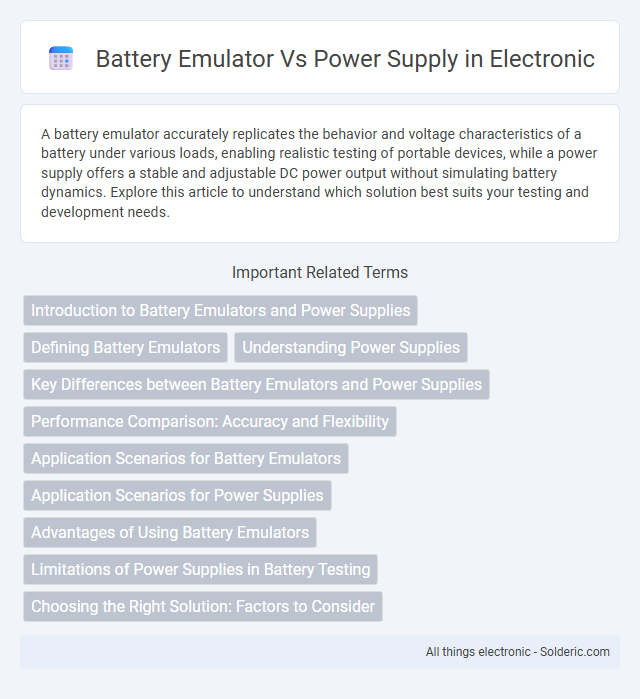A battery emulator accurately replicates the behavior and voltage characteristics of a battery under various loads, enabling realistic testing of portable devices, while a power supply offers a stable and adjustable DC power output without simulating battery dynamics. Explore this article to understand which solution best suits your testing and development needs.
Comparison Table
| Feature | Battery Emulator | Power Supply |
|---|---|---|
| Purpose | Simulates real battery behavior in testing and development | Provides stable and adjustable DC power output |
| Output Characteristics | Variable voltage/current matching battery profiles | Fixed or programmable voltage/current levels |
| Application | Battery management system (BMS) testing, battery pack simulation | General electronic device powering and lab testing |
| Load Handling | Emulates dynamic load conditions of batteries | Handles consistent load conditions |
| Energy Storage | No energy storage, purely simulation function | No energy storage, supplies energy from AC mains |
| Cost | Typically higher due to advanced simulation features | Generally lower cost, simpler design |
| Examples | Keysight N6781B, Chroma 17011 | Tektronix PWS4305, Rigol DP832 |
Introduction to Battery Emulators and Power Supplies
Battery emulators simulate the electrical characteristics of batteries, providing accurate voltage and current behaviors for testing and development purposes. Power supplies deliver a stable and adjustable source of electrical power but lack the dynamic response typically exhibited by real batteries in varying load conditions. Your choice between a battery emulator and a power supply depends on the need for realistic battery simulation versus simple power delivery in electronic testing.
Defining Battery Emulators
Battery emulators replicate the electrical characteristics of real batteries to provide accurate voltage, current, and dynamic load responses for testing electronic devices without the need for actual batteries. Unlike conventional power supplies that deliver fixed or adjustable DC voltage, battery emulators simulate battery behavior such as discharge curves, internal resistance, and transient response. This precision allows engineers to evaluate device performance under realistic battery conditions in automotive, portable electronics, and renewable energy applications.
Understanding Power Supplies
Power supplies provide a constant voltage or current to power electronic devices during testing, ensuring stable operation under various conditions. Battery emulators, on the other hand, mimic the electrical characteristics of batteries, such as voltage sag and discharge behavior, to accurately simulate real-world battery performance. Understanding these differences helps you choose the right tool for testing and development of battery-powered systems.
Key Differences between Battery Emulators and Power Supplies
Battery emulators simulate the voltage and current characteristics of real batteries, enabling precise testing of battery-powered devices under varying load conditions, while power supplies provide a stable and adjustable DC output without mimicking battery behavior. Battery emulators typically include features like dynamic load regulation, charge/discharge cycle simulation, and state-of-charge emulation, which are absent in standard power supplies. Key differences lie in the purpose of application, output behavior, and the ability to replicate battery-specific responses for comprehensive device testing.
Performance Comparison: Accuracy and Flexibility
Battery emulators offer high accuracy in simulating real battery behavior, providing dynamic load responses and precise voltage-current profiles closely matching actual battery conditions. Power supplies deliver stable voltage and current but lack the flexibility to mimic complex battery discharge curves and internal resistance variations, limiting their effectiveness in battery testing scenarios. Your choice depends on the need for accurate replication of battery characteristics versus straightforward power delivery for general testing purposes.
Application Scenarios for Battery Emulators
Battery emulators are essential in testing applications where simulating real battery behavior is critical, such as in electric vehicles, portable electronics, and renewable energy storage systems. They provide precise control over voltage, current, and discharge profiles, enabling developers to validate battery management systems without risking actual batteries. Your product development becomes safer and more efficient by using battery emulators for scenarios requiring accurate replication of battery performance under various load conditions.
Application Scenarios for Power Supplies
Power supplies are essential in laboratory testing, prototyping, and quality control where stable, adjustable voltage and current outputs ensure accurate simulation of various electrical conditions. They are widely used in electronics manufacturing for functional testing of devices, enabling consistent power delivery to assess performance under controlled settings. Power supplies also facilitate circuit debugging and validation by providing precise control and protection features critical for safe and reliable operation.
Advantages of Using Battery Emulators
Battery emulators provide precise control over voltage, current, and state of charge, enabling accurate simulation of real battery behaviors in testing environments. They improve safety by eliminating risks associated with high-capacity batteries and reduce testing time through configurable settings that mimic various battery chemistries. Compared to traditional power supplies, battery emulators deliver dynamic load response and programmable discharge profiles essential for validating battery management systems and energy storage applications.
Limitations of Power Supplies in Battery Testing
Power supplies often fail to replicate the dynamic discharge characteristics and internal resistance variations of real batteries, limiting accuracy in battery testing. Unlike battery emulators designed to mimic these behaviors precisely, power supplies provide constant voltage or current outputs without simulating real battery responses under load fluctuations. Your battery testing results may be less reliable if relying solely on power supplies, as they cannot fully capture the transient behavior and state-of-charge dynamics crucial for advanced battery validation.
Choosing the Right Solution: Factors to Consider
Choosing between a battery emulator and a power supply depends on your testing requirements, such as voltage precision, current capacity, and load response. Battery emulators closely mimic real battery behavior, including discharge curves and dynamic load changes, making them ideal for accurate battery simulation in device development. Your decision should factor in cost, complexity, and whether you need real-time battery conditions or just stable power output for testing.
Battery emulator vs power supply Infographic

 solderic.com
solderic.com